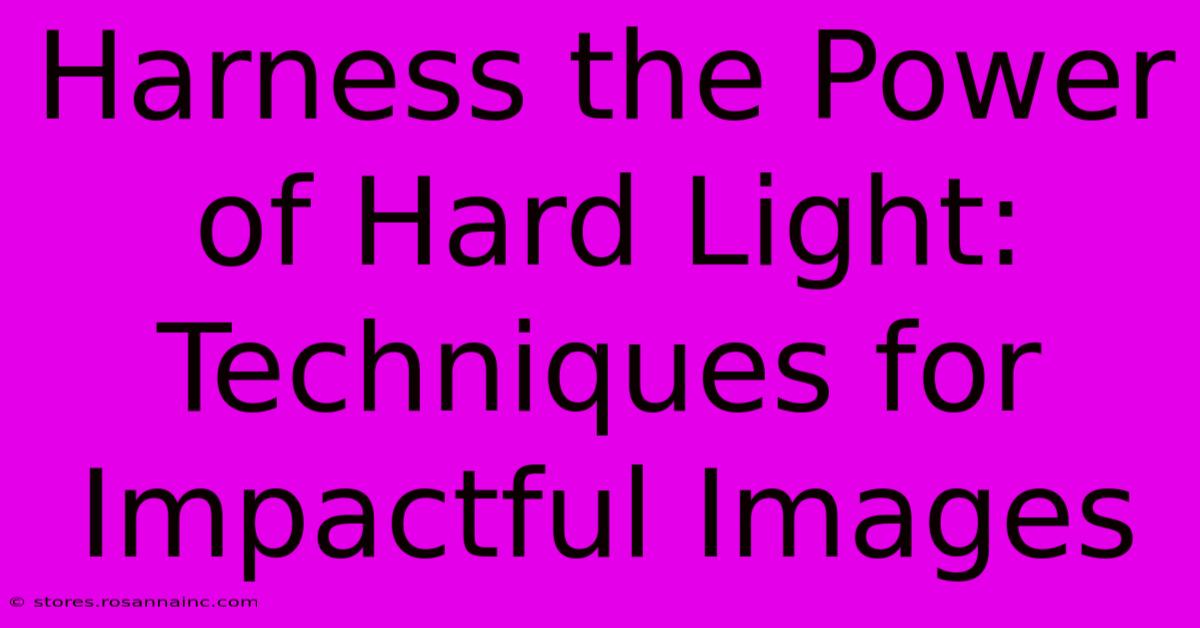Harness The Power Of Hard Light: Techniques For Impactful Images

Table of Contents
Harness the Power of Hard Light: Techniques for Impactful Images
Hard light. The very term evokes a sense of drama, intensity, and strong contrast. Unlike soft light, which gently caresses subjects, hard light casts deep shadows and creates a stark, defined look. Mastering hard light photography opens up a world of creative possibilities, allowing you to craft impactful images with a powerful visual punch. This guide will delve into techniques to harness the power of hard light and elevate your photography.
Understanding Hard Light
Before we dive into techniques, let's define what constitutes hard light. Hard light is characterized by its small light source relative to the subject. This small source produces sharply defined shadows with a high contrast ratio between the highlights and shadows. Think of the midday sun on a clear day – that's hard light in its purest form.
Key Characteristics of Hard Light:
- Strong Shadows: Deep, well-defined shadows are the hallmark of hard light.
- High Contrast: Significant difference in brightness between illuminated and shadowed areas.
- Dramatic Effects: Creates a sense of intensity and drama in your images.
- Textural Emphasis: Highlights textures and surface details effectively.
Techniques for Utilizing Hard Light
Hard light isn't just about harsh sunlight. You can create and control hard light in various ways, regardless of the time of day or weather conditions.
1. Embrace the Midday Sun
The most readily available hard light source is the midday sun. While often avoided by photographers seeking soft, diffused light, the midday sun can be a powerful tool. Use it to:
- Create Strong Silhouettes: Position your subject between the sun and your camera for dramatic silhouettes.
- Highlight Textures: The strong shadows emphasize textures in materials like wood, stone, or fabric.
- Capture Dramatic Portraits: Use fill flash or reflectors to balance the harshness and create captivating portraits.
2. Utilizing Artificial Hard Light Sources
Artificial lighting offers precise control over hard light. Small strobes, spotlights, or even a single bare bulb can be used to create hard light effects. Experiment with:
- Light Placement: Vary the position of the light source to manipulate the shadows and highlights. Side lighting creates strong contrast, while backlighting can produce striking rim lighting.
- Light Modifiers: While hard light is defined by its lack of diffusion, you can still use modifiers like grids or snoots to further control the light’s spread and intensity.
- Multiple Light Sources: Combining multiple hard light sources allows for complex lighting setups with creative shadow play.
3. Reflectors and Fill Flash
While hard light is characterized by strong contrast, you can soften its impact using reflectors or fill flash. A reflector bounces light back into the shadows, reducing contrast and adding detail. Fill flash provides a controlled burst of light to brighten shadows, balancing the harshness of the hard light.
4. Post-Processing Techniques
Post-processing can further enhance images shot with hard light. Tools like dodging and burning allow for precise adjustments to highlights and shadows, refining contrast and detail. Consider using:
- Contrast Adjustments: Increase contrast for a more dramatic look, or decrease it slightly for a more balanced image.
- Shadow and Highlight Recovery: Recover detail in overly bright or dark areas.
- Selective Adjustments: Apply adjustments to specific areas of the image to fine-tune the effect.
Subjects Ideal for Hard Light
Certain subjects are particularly well-suited to hard light photography. These include:
- Architectural Photography: Hard light accentuates the texture and details of buildings and structures.
- Landscape Photography: Creates dramatic contrasts in landscapes, highlighting mountains, rocks, and other features.
- Portrait Photography: Can be used to create intense and dramatic portraits, emphasizing facial features and textures.
- Still Life Photography: Highlights the textures and details of objects, creating visually interesting compositions.
Conclusion: Mastering Hard Light for Impactful Images
Hard light, often perceived as challenging, is a powerful tool for creating impactful and visually arresting images. By understanding its characteristics and employing the techniques outlined above, you can harness its potential and elevate your photography to a new level. Experiment, explore, and discover the unique and dramatic beauty that hard light can bring to your work. Remember that practice is key! The more you experiment with different light sources, angles, and post-processing techniques, the better you'll become at using hard light to your creative advantage.

Thank you for visiting our website wich cover about Harness The Power Of Hard Light: Techniques For Impactful Images. We hope the information provided has been useful to you. Feel free to contact us if you have any questions or need further assistance. See you next time and dont miss to bookmark.
Featured Posts
-
Unleash The Power The Ultimate Guide To Dnd Gel 295
Feb 04, 2025
-
Orange Roses A Vibrant Canvas For Emotional Expression
Feb 04, 2025
-
Invitation Inspiration Discover The Heavenly Designs That Will Guide Your Child To The Eucharist
Feb 04, 2025
-
Unveiling Natures Emerald Aisle Discover The Majestic World Of Palm Greenery
Feb 04, 2025
-
Breakthrough In Oral Care Dnd Gel 861 Eliminate Bad Breath Cavities And Gum Disease
Feb 04, 2025
